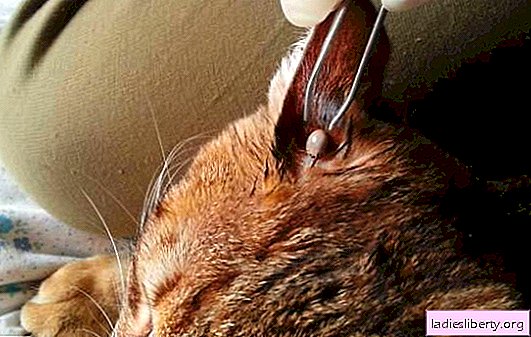
Ticks are arthropod insects that parasitize humans and animals. For kittens, different types of ticks can cause serious diseases.
Ixodid tick in a kitten - what to do?
These blood-sucking insects attack people and pets while walking in the park or hiking in the forest. They live in grass and shrubs, they become especially active in May-June, as well as in early autumn. The highest probability is to pick a tick from a kitten who is allowed to walk outside or take with them to the cottage. But the hosts can bring this parasite home on clothes, from where it is then able to move to the animal. Outwardly, the tick looks like a small spider. He moves very quickly and is so small that he is most often noticed even when he is sucked and swollen from drunk blood. In this case, the insect increases in size from three millimeters to one and a half centimeters, its abdomen acquires a brown-red hue.
Ticks in cats are found on different parts of the body, but most often they are attached in the abdomen, behind the ears, on the withers, on the hind legs, in the armpits. The animal may not immediately notice the "passenger", because with a bite a tick releases an anesthetic into the wound. It is contained in the saliva of the insect, which also has the ability to harden and firmly fix the proboscis of the blood-sucking parasite. The longer the tick remains on the animal, the more difficult it will be to remove it later.
An ixodid tick is dangerous for a kitten, as it is a carrier of serious diseases: pyroplasmosis, teileriosis, tularemia. Therefore, after walking, you must always carefully examine the pet, and if a blood-sucking parasite is found, it must be removed as soon as possible. This must be done correctly. It is best to use a special tool.

If the animal regularly walks on the street, it is advisable to purchase such a device in a pet store and always have it at hand. With this tool you need to gently grab the tick as close to the head as possible and slowly twist it. It is recommended to carry out the procedure with gloves, because tick saliva can contain viruses that are dangerous to humans. It is very important to remove the parasite along with the head, otherwise inflammation can be provoked. It is not recommended to pull the insect, try to pull it out with a thread or sharp tweezers, drip oil on it. Either the body will come off, and the head will remain inside, or the tick will squeeze the jaws even more, and it will not work to pull it out entirely. You can take the kitten to the vet, and entrust the doctor with the correct extraction of the parasite.
After a tick bite, the kitten must be carefully monitored for the next two to three weeks, since the incubation period of the disease lasts a long time. The following symptoms are alarming:
• pale gums and mucous membranes (indicate the development of anemia);
• lethargy, loss of appetite;
• high temperature (40 degrees and above);
• loose stools, vomiting;
• labored breathing.
If you notice a cat’s malaise, you need to urgently contact a veterinary clinic and inform your doctor that the animal has been bitten by a tick. Making the right diagnosis will help to prescribe an adequate treatment.
Kitten ear mite - what to do?
This type of tick is called Otodectes cynotis, hence the name of the disease - otodectosis. Small arthropods, less than a millimeter in size, parasitize in the ears of cats and dogs. Infection occurs either from a sick animal, or through related items, such as a rug or bed. The problem of an ear tick is relevant mainly for kittens taken from the street. But also a small kitten can get an ear tick from a cat mom or from another pet in the house who is allowed to walk.
Signs of infection of a kitten with an ear tick:
• brown plaque in the ear canal;
• the kitten often scratches his ears, shakes his head;
• scratches and crusts appear in the ears.

If otodectosis is suspected, an analysis of the discharge from the ears of the kitten should be performed. This is done in the veterinary clinic. Only after the diagnosis is confirmed can treatment be started. It includes cleansing the ears with a special lotion and subsequent instillation of the drug against ticks. In the mild case of infection, the owner can independently clean the ears of the kitten and then administer drops prescribed by the doctor. If pus and blood are present in the discharge, and the ear canal is literally clogged with dirt, it is better to entrust the first cleaning to the doctor. In complicated cases, the veterinarian can also prescribe antibacterial and antifungal drugs.
Subcutaneous tick in a kitten - what to do?
If the kitten constantly itches, hair begins to fall out on its head, neck, ears and especially around the eyes, the skin turns red, blackheads and pustules appear on it, it can be suspected that the pet has demodicosis.

It is caused by the demodex tick. This type of subcutaneous ticks can exist in a healthy animal, it is activated when weakened immunity. To determine the presence of a parasite in a kitten, you can use a scraping test from the skin. It is not worth delaying a visit to the doctor - as long as demodicosis is localized in certain areas, therapy will be more effective. The doctor will select special shampoos and lotions for cleansing the skin for the kitten, as well as an anti-mite drug. Be sure to demodicosis prescribed funds to enhance the immunity of the animal. You will also have to disinfect all cat toys, bowls, bedding.
A tick in a kitten - what to do for prevention?
To protect a small cat from dangerous parasites such as ticks, a number of rules must be followed:
1. Try to prevent contact of the domestic kitten with stray animals.
2. Regularly inspect the pet’s ears, check the condition of its skin and coat. This primarily applies to animals that have access to the street. They also need to regularly conduct treatment from external parasites.
3. If the owners take the kitten with them outside the city or let them go for a walk, you need to use tick protection. It can be sprays, drops that are applied to the withers or a special collar.











